Answers: May 19, 2022
Here are this week’s answers:
Question 1
WHEN TO TREAT FOR GRUB WORMS
Dear Neil: I’ve seen lots of June bug activity. This seems very early. Is it? When should we treat for grub worms? Wade T., Watauga and David D. in Van Zandt Co.
Answer: You may not be seeing the same species of beetles whose larvae do the damage to Texas turfgrass. The damaging types are the smaller June beetles that emerge in May in South Texas and in early to mid-June farther north (where both of you are). Timing of treatment with labeled granules would be early June in South Texas, mid-June in the I-20 corridor and late June into the Panhandle.
Return to list of this week’s questions.
Question 2
CITY’S WATERING RESTRICTIONS THREATEN NEW SHRUBS, TREES
Dear Neil: Due to the drought locally we are allowed to water only once per week. What can we do with new trees, shrubs and turf grass? Steve S., Comal Co.
Answer: Most cities will allow you to water new plantings with a garden hose if you are standing there and doing so by hand with a hose and a water breaker or bubbler. That certainly would work for your trees and shrubs. Apply an amount of water equal to the size of the pot from which the new plant was taken. Repeat that on 2- or 3-day intervals until mid-fall. If your city won’t even allow that you may be forced to carry “gray water” (from bathtubs, dish water, etc.) to them. But they have to have water. If the turfgrass is well established it should be fine with the weekly irrigation.
Return to list of this week’s questions.
Question 3
SEQUENCE OF FLOWERING PERENNIALS
Dear Neil: Can you give us a sequence of perennials, spring to fall and short to tall for a 2- X 12-foot garden? Stephen C., Waco.
Answer: You will rarely see or hear me do this in an answer, but only because I spent several weeks preparing the exact list that you’ve requested, you’ll find it on pages 222 – 231 of Neil Sperry’s Lone Star Gardening. It would be impossible to replicate that list here. The charts that I have in the Perennials chapter also give you information on the colors they provide, textures, growth forms and overall performance or more than 120 of the most popular perennials grown in Texas. The one thing I will tell you is that a bed of that size won’t have as much room as one might imagine. You’ll probably have space for 8 or 10 types of perennials, perhaps a few more if you include bulbs. Don’t overcrowd them. Oh, and if you happen to buy the book and feel you didn’t get your money’s worth, I always offer a full money-back refund policy. 75,000 copies sold and no refund requests so far. You’ll see the links to buy it in this newsletter. It’s not sold in stores.
Return to list of this week’s questions.
Question 4
CONTROL OF NUTSEDGE IN FLOWERBEDS
Dear Neil: I have a large amount of nutsedge (“nutgrass”) in a flowerbed containing phlox, daylilies, Peruvian daffodils and a rose-of-Sharon. Is Image or Sedgehammer safe for use in such a setting?
Answer: Sedgehammer’s label specifically limits its use to turf areas. However, Image (Imazaquin) can be applied around some perennials. Clemson University has good information on Image.
Return to list of this week’s questions.
Question 5
HOW SHOULD I RESOLVE PISTACHIO PROBLEMS?
Dear Neil: Each year our Chinese pistachio puts out wonderful new growth in the spring. Shortly thereafter and for the remainder of the summer the leaves and branches intermittently die. How can I stop the cycle, or should I just cut it down? Brian S., Frisco.
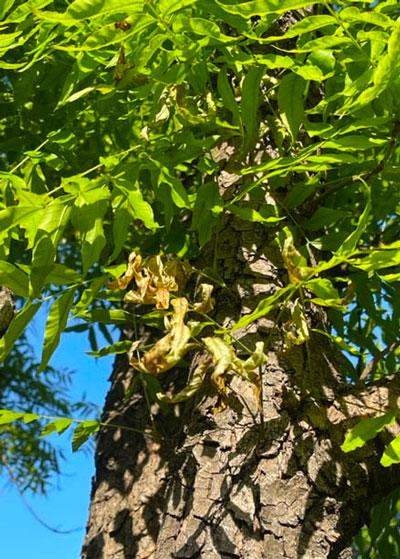
Answer: I certainly would not cut it down yet. At least not without having a certified arborist take a look at it. I can’t see enough detail in your photograph to tell what might be going wrong, but if it’s only a few leaves at a time, there may be some minor insect damage. Try to look at the interface of dead leaves and healthy leaves to see if you can find any indication of what kind of damage might be happening. That’s all I can offer from the small photo.
Return to list of this week’s questions.
Question 6
EXPLAIN DIFFERENCES IN RED OAKS’ COLORS
Dear Neil: I live in a townhome community and each of the 80 units has a red oak in the front. Within about the past month, two dozen of the trees have browning leaves and are not as green as the others. What might be happening? Lorraine C., Tyler.
Answer: As with others, you need to have a certified arborist out to look at your trees. If they’re light green, that would suggest lack of nitrogen. In areas farther west (alkaline soils) it could be due to lack of soluble iron, but not in Tyler. There could be active decay in the trunks, although that’s not likely in that many trees. Perhaps there has been damage done to their roots. The arborist would be able to tell by looking. Generally, problems of this sort aren’t in the leaves, but instead in the roots or the trunks, so a photo of the browning leaves doesn’t help as much. Get a veteran ISA Certified Arborist out for a consultation.
Return to list of this week’s questions.
Question 7
WHAT’S HAPPENING TO MY YAUPONS?
Dear Neil: My yaupon hollies were healthy before. Now they’re turning brown and crisp. Why would this happen? Jill B., College Station.
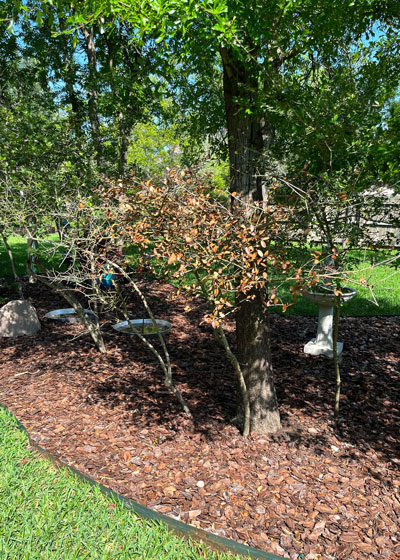
Answer: I grew up in College Station, so I know yaupons quite well. I’ve never seen an insect or disease kill them. Drought certainly will, and so will transplant shock (in case these were recently dug and transplanted). These face a lot of competition for water by being planted so close to the trees. I suspect that’s at least partially to blame.
Return to list of this week’s questions.
Question 8
WHAT TO DO WITH TULIP AND JONQUIL BULBS NOW?
Dear Neil: I planted tulip and jonquil bulbs last December and they did great this spring. Do I need to dig and store the bulbs or should I leave them planted? Dale, San Antonio.
Answer: Tulips are generally handled as annuals in Texas. That means they’re dug and discarded soon after bloom. Only the uncommon “species” types are reliable rebloomers in our warm southern climate. Jonquils may come back and bloom again in successive springs, so leave them right where they are.
Return to list of this week’s questions.
Question 9
SHOULD LIVE OAK BE PRUNED?
Dear Neil: Our 40-year-old live oak was hurt by the winter of 2021. Should we remove the dead branches in summer or trim them now? Jory W., Forney.
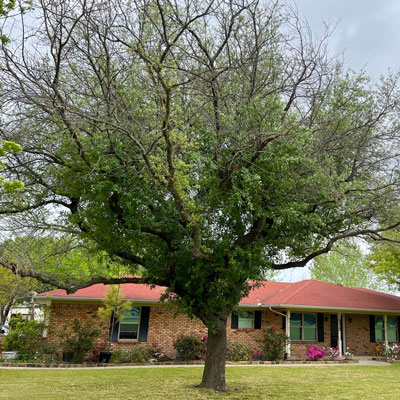
Answer: They should be removed soon so that they don’t start breaking and doing damage to the other parts of the tree and to people and pets beneath them. Have a certified arborist do this work for you and have him or her apply pruning sealant to each fresh cut to help prevent the spread of oak wilt.
Return to list of this week’s questions.
Question 10
WHAT CAUSES THIS BLACK OOZE ON A HOLLY?
Dear Neil: I have several mature Nellie R. Stevens shrubs. One of them is oozing a black substance. I’ve been watching it for six weeks. What should I do? Jim S., Arlington.
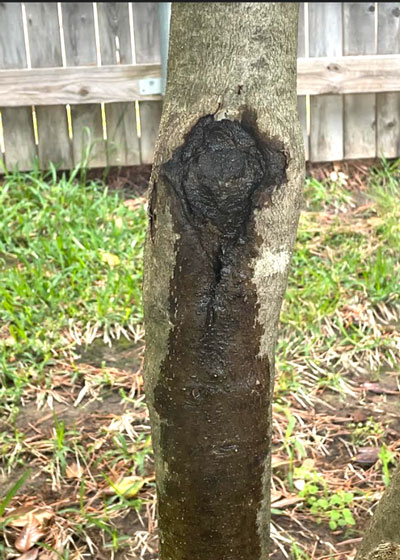
Answer: This is moisture seeping from active decay. The branch that was removed still has not healed properly and decay has set in, probably deep within the trunk. I am concerned about whether the tree can even survive at this point. I also see the crack, which is further development of the decay. Hopefully it will survive the ordeal, but there isn’t anything you can do to help speed it up.
Return to list of this week’s questions.
Question 11
WHAT’S BEST FOR EROSION CONTROL?
Dear Neil: Our house is downhill from neighbors on three sides. When we have heavy rains water pours like a stream. Over 8 years my soil is very eroded. What will stop that? Deirdre L-M, Bexar Co.
Answer: You need a plant with tenacious roots. Turfgrass ranks at the top of the list, so St. Augustine for South Texas and bermudagrass in full sun in North Texas. I’ve had really good luck with mondograss (regular monkeygrass/Ophiopogon) in shade or part shade at our house. I looked at your video, and I see what has you concerned. You might want to have a veteran landscape contractor do site work to install drains and grates for you.
Return to list of this week’s questions.
Question 12
OCTOBER GLORY RED MAPLES GOING DOWNHILL QUICKLY
Dear Neil: I had three October Glory red maples planted in a row in December 2021. Just in the past week the leaves on the middle tree started to droop and now they are brown. The other trees look fine. What is causing this? Chris O., Waxahachie.
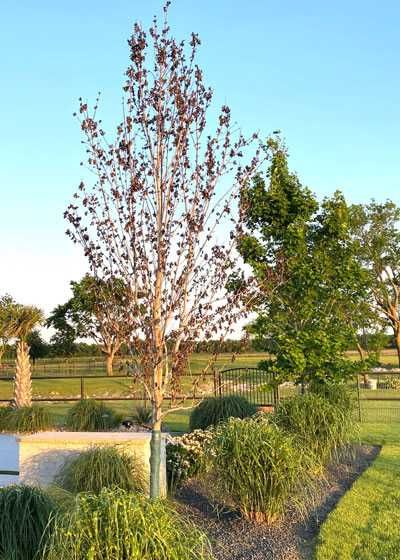
Answer: Either this is transplant shock or the tree got too dry one or more times. If the trees were planted out of pots, it got too dry. If they were dug and balled-and-burlapped, this tree suffered too much root loss. Insects and diseases wouldn’t attack this quickly.
Return to list of this week’s questions.
Question 13
BROWN PATCH OR TARR?
Dear Neil: I’m trying to determine if this is brown patch or TARR. It’s been there for about a year. It doesn’t go away, but it’s not getting any better, either. Eloise F., Richardson.
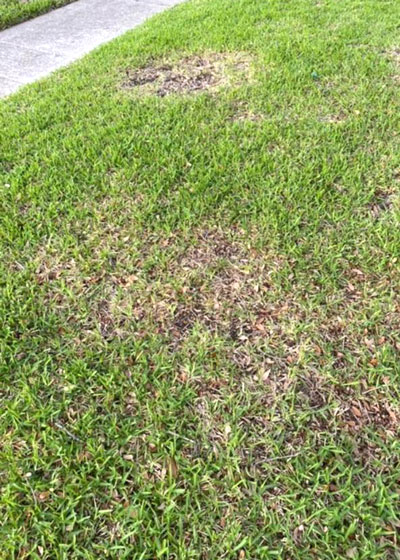
Answer: It looks more like last fall’s brown patch (“large patch”), but that’s a cool-season disease of the autumn in North Texas. Take all root rot normally causes yellowish washes across the lawn in early spring, not the distinct browned areas. Pull on some of the declining grass one blade at a time. If it’s brown patch the blades will come loose easily and the runners will remain attached to the soil. If it’s TARR the leaves and runners will remain attached and both will pull loose from the ground without much resistance. Either way, the fungicide Azoxystrobin will control both diseases. If you want to be absolutely sure of the pathogen before you start treating, send photos and samples to the Texas Plant Clinic at Texas A&M. There will be a charge for them to culture the samples, but you’ll end up with a clear answer. Here is a link to their website: https://plantclinic.tamu.edu
Return to list of this week’s questions.
Question 14
CALCIUM FOR BETTER TOMATOES?
Dear Neil: I have heard that tomatoes do better with calcium added to the soil. What is the best source of calcium for tomatoes?
Answer: You’ve probably seen or heard references to a problem known as blossom-end rot where the far end of the fruit develops a blackened, sunken area rendering the fruit unusable. This has been thought to be a lack of calcium, but many of us have found that consistent monitoring of watering is a better solution. Keep your plants uniformly moist at all times and you will see far less blossom-end rot. That’s especially true for plants you are growing in containers. Fall garden tomatoes (from transplants set out around July 1) are of still better quality. Please see this information from the scientists at Iowa State University. https://hortnews.extension.iastate.edu/blossom-end-rot
Return to list of this week’s questions.
Question 15
CRAPE MYRTLE FOR INTENSELY HOT LOCATION
Dear Neil: Is there a crape myrtle that can handle the intense, triple-digit West Texas heat we are already having? I need one that grows to 20 ft. or taller. Should I wait until October to plant it? Linda W., Tom Green Co.
Answer: Those of you in and around San Angelo should do just fine with any of the crape myrtle varieties other than the miniature weeping types. (They are not reliably winter-hardy in your area.) If you will soak their soil they will keep blooming on and off all through the summer. Choose any of the taller types from this list of the best varieties. We on the Crape Myrtle Trails of McKinney horticulture committee polled national experts as we put this list together. This was the combined list of recommended types: https://crapemyrtletrails.org/varieties/best-crape-myrtles-by-size/
Return to list of this week’s questions.
Question 16
2,4-D ON ST. AUGUSTINE?
Dear Neil: I’ve heard you recommend 2,4-D to control weeds in St. Augustine, but the product labels say it should not be used on that grass. Thoughts? Cindy H., Friendswood.
Answer: Hats off to you for reading the product label! First of all, be sure you have a weed that really needs 2,4-D. It’s a broadleafed herbicide, meaning that it’s for the control of non-grassy weeds. Granted, there are several that do co-exist within St. Augustine turf, so perhaps you do need help in controlling them. I would suggest using a spray and applying it with a pump sprayer or a trigger bottle so that you can be very precise in the application. Keep it off the grass as much as possible. In fact, try it on a small area that’s out of sight and see how it looks after 10 days. St. Augustine is more “delicate” that bermudagrass, so it stands to reason that it might be damaged in extreme heat. Spray on a cool day if you can find one, and spray late in the day or very early in the morning – certainly not in mid-afternoon. It might also help if you found a product containing only 2, 4-D and not a combination of two additional herbicides. Independent retail garden centers are most likely to have such products. Still, try it on a small area first to see if it has any ill effects.
Return to list of this week’s questions.
Question 17
WILL ROSE-OF-SHARON SURVIVE?
Dear Neil: My rose-of-Sharon was hurt badly by the cold of February 2021. One branch died, then another didn’t leaf out this year. I trimmed it up. Do you think it will survive? Connie P., West.
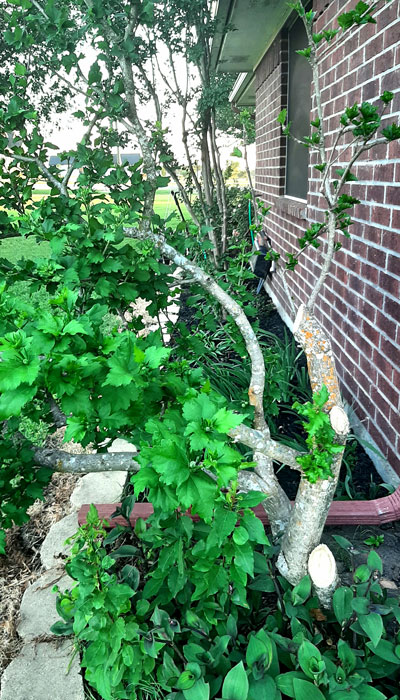
Answer: Roses-of-Sharon are winter-hardy clear to the Great Lakes and beyond. I’m not meaning to sound argumentative, but I’d be amazed if what we experienced in February 2021 would have been extreme enough to have done serious harm to your plant, especially tucked up against the house as it is. But, having said that, I have nothing else to offer as a possibility. My advice is that you wait it out and see what happens.
Return to list of this week’s questions.
Question 18
CUT RED MAPLE TO GROUND?
Dear Neil: My red maple has gone downhill in a matter of a few weeks. If I cut it to the ground will it regrow into a good tree? James M., Prairieville, Van Zandt Co.
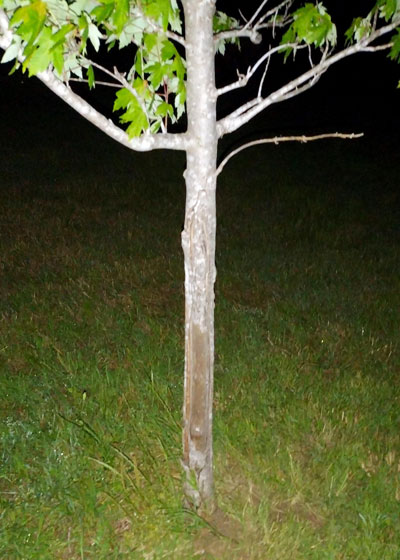
Answer: I’ve never seen that tried on a maple. Before I did that I would give the tree this growing season to see if it can form a roll of new bark across the injury. This looks like sunscald. I suspect this is the west or southwest side of the trunk, and I’d further guess that this trunk was not wrapped for its first couple of years after planting. Sunscald is an extremely serious problem for red maples, Chinese pistachio, red oaks and other smooth-barked trees until they form enough leaf canopy to protect themselves from the sun.
Return to list of this week’s questions.
